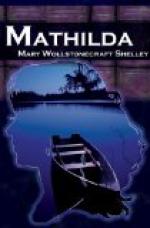INTRODUCTION
Of all the novels and stories which Mary Wollstonecraft Shelley left in manuscript,[i] only one novelette, Mathilda, is complete. It exists in both rough draft and final copy. In this story, as in all Mary Shelley’s writing, there is much that is autobiographical: it would be hard to find a more self-revealing work. For an understanding of Mary’s character, especially as she saw herself, and of her attitude toward Shelley and toward Godwin in 1819, this tale is an important document. Although the main narrative, that of the father’s incestuous love for his daughter, his suicide, and Mathilda’s consequent withdrawal from society to a lonely heath, is not in any real sense autobiographical, many elements in it are drawn from reality. The three main characters are clearly Mary herself, Godwin, and Shelley, and their relations can easily be reassorted to correspond with actuality.
Highly personal as the story was, Mary Shelley hoped that it would be published, evidently believing that the characters and the situations were sufficiently disguised. In May of 1820 she sent it to England by her friends, the Gisbornes, with a request that her father would arrange for its publication. But Mathilda, together with its rough draft entitled The Fields of Fancy, remained unpublished among the Shelley papers. Although Mary’s references to it in her letters and journal aroused some curiosity among scholars, it also remained unexamined until comparatively recently.
This seeming neglect was due partly to the circumstances attending the distribution of the family papers after the deaths of Sir Percy and Lady Shelley. One part of them went to the Bodleian Library to become a reserved collection which, by the terms of Lady Shelley’s will, was opened to scholars only under definite restrictions. Another part went to Lady Shelley’s niece and, in turn, to her heirs, who for a time did not make the manuscripts available for study. A third part went to Sir John Shelley-Rolls, the poet’s grand-nephew, who released much important Shelley material, but not all the scattered manuscripts. In this division, the two notebooks containing the finished draft of Mathilda and a portion of The Fields of Fancy went to Lord Abinger, the notebook containing the remainder of the rough draft to the Bodleian Library, and some loose sheets containing additions and revisions to Sir John Shelley-Rolls. Happily all the manuscripts are now accessible to scholars, and it is possible to publish the full text of Mathilda with such additions from The Fields of Fancy as are significant.[ii]




